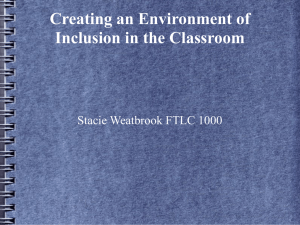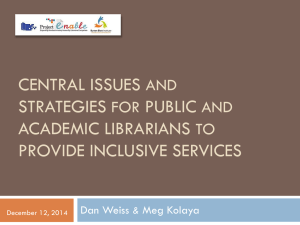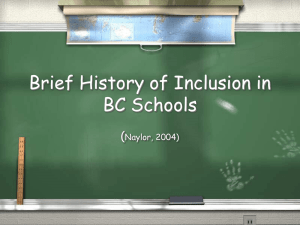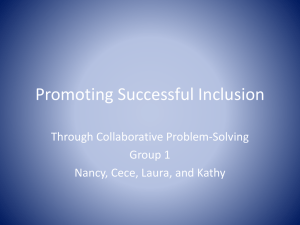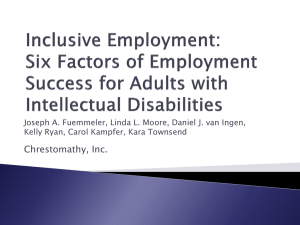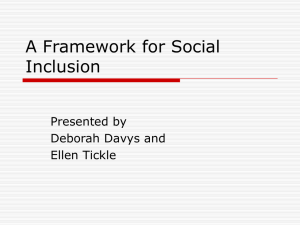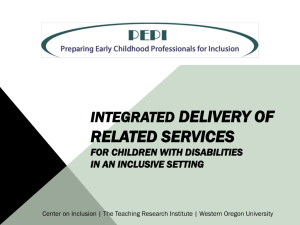Session 1: Opportunities, Initiatives and Key Resources
advertisement
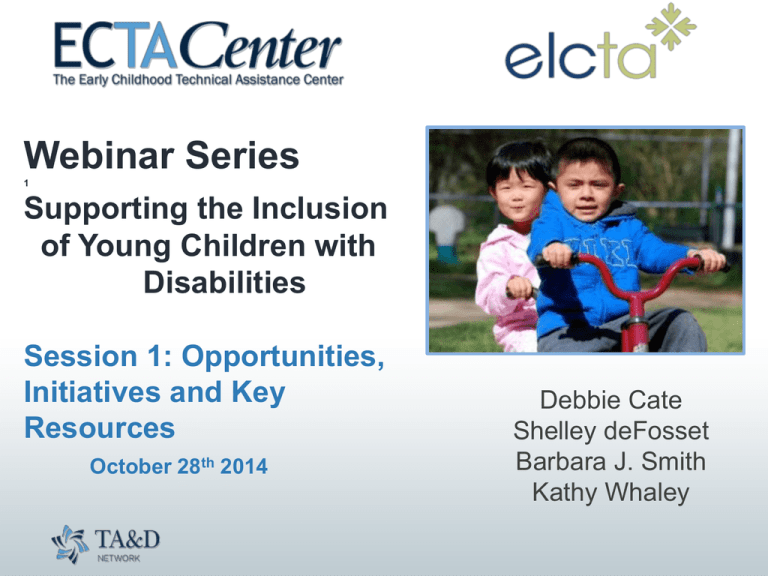
Webinar Series 1 Supporting the Inclusion of Young Children with Disabilities Session 1: Opportunities, Initiatives and Key Resources October 28th 2014 Debbie Cate Shelley deFosset Barbara J. Smith Kathy Whaley Objectives Share information about: National initiatives supporting inclusion, National educational environments data, National survey results on preschool inclusion, and Resources and materials supporting inclusion, including future webinars. National Initiatives and Opportunities in Support of Inclusion Federal Public Awareness Campaign with a Position Paper on Inclusion DEC Special Initiative on Inclusion RTT-ELC and Pre-School Development Grants ECTA/ ELC TA Partnership The Inclusion Forum provided an opportunity for discussion and problem solving: • State practices integrating IDEA programs into TQRIS/QRIS • Strengthening agency partnerships for a coordinated approach to serving children with disabilities Priorities Selected by Participants • Defining and measuring quality indicators for Part B/619 and Part C • Incorporating incentives for school-based early childhood programs in TQRIS/QRIS • Incorporating incentives for other early childhood programs in TQRIS/QRIS Priorities, continued • Providing professional development and technical assistance to support inclusive practice • Developing cross-sector professional development to ensure staff are adequately prepared • Using data to inform decisions (at all levels) about professional development, resources, administration, policies, and program practices. SPP APR Indicator 6 Measurement: A. Percent of children aged 3 - 5 with IEPs attending a regular early childhood program and receiving the majority of special education and related services in the regular early childhood program. B. Percent of children aged 3 - 5 with IEPs attending a separate special education class, separate school or residential facility. Indicator Results 2012-2013 Data reported for IDEA 2012 Educational Environments 2012-13: Percent of Children Attending: Regular EC Program Special Education 42% And receiving the majority of special education in the program 26% Special education class, separate school, or residential facility 6A: Percent of children with IEPs attending a regular early childhood program (RECP) and receiving the majority of services in the program 100.0 80.0 60.0 40.0 20.0 0.0 Each diamond represents a state or territory, SPP/APR SY 2012-2013 Indicator 6B: Percent of children with IEPs attending a special education program Each diamond represents a state or territory, SPP/APR SY 2012-2013 B6 Data Reporting Tools Tools from the IDEA Data Center: Excerpts from the Technical Guide – Children with Disabilities (IDEA) Early Childhood File Specifications https://www.ideadata.org/tools-products Source: EDFacts, File CO89 B6 Data Reporting Tools Decision Tree and Measurement Table debbie.cate@unc.edu Preschool Inclusion Survey (Barton & Smith, 2014) The last national look at challenges and solutions was conducted almost 25 years ago (Smith, Salisbury & Rose, 1992) The Facts Inclusion benefits all children Children can be effectively educated in inclusive programs using specialized instruction Families of all children generally have positive views of inclusion Inclusion is not more expensive Children do not need to be “ready” The Facts Research is clear: it’s effective IDEA is clear: it’s preferred The profession is clear: DEC/NAEYC position statement And Yet In 27 years inclusion has increased only 5.7% And many children continue to be educated in separate settings. Source: OSEP annual reports: 1987 (1984-85 data); 2014 (2012 data) The Survey • Preschool inclusion definition: when children (age 3 – 5) with Individual Education Programs (IEP) receive their special education and related services in settings with at least 50% of peers without IEPs • January 2014 • Electronic survey to 619 Coordinators; asked that they send to others • Asked what are the challenges and solutions The Survey Respondents 238 people responded from 32 states and 1 territory The Survey: Roles Roles N % School District Special Education Preschool Coordinator or Child Find Coordinator 50 21.0% School District Special Education Director 49 20.6% School District Early Childhood Administrator 38 13.81% State Section 619/IDEA Preschool Coordinator 35 14.7% Head Start Administrator ECSE/Sped Teacher/Consultant State Special Education Director School Principal School Psychologist 24 17 10 7 3 10.1% 7.1% 4.2% 2.9% 1.3% Overall Challenges • Attitudes & Beliefs • Fiscal & contracting • Approval of non-public school setting • Curricula/methods • Transportation • Personnel qualifications • Conflicting policies • Program quality Survey Results: Challenges • Attitudes & Beliefs • Fiscal & contracting • Approval of non-public school setting • Curricula/methods • Transportation • Personnel qualifications • Conflicting policies • Program quality 30% 19% 16% 15% 15% 11% 10% 10% 3 Categories of Challenges Attitudes & Beliefs Policies/Procedures Resources Attitude & Belief Challenges • Lack of Communication/collaboration • Lack of awareness/understanding • “Someone will lose” Beliefs • Staff preparedness • Turf issues • Lack of respect • Other Attitude & Belief Challenges • Lack of Communication/collaboration (20%) • “Someone will lose” Beliefs (20%) • Staff preparedness (17%) • Lack of awareness/understanding (16%) • Turf issues (14%) • Lack of respect (12%) • Other (1%) Policy/Procedures Challenges • 19 of 70 maybe policy • Most local, then state, then federal • Categories of policy/procedure challenges: Ensuring quality (standards, curricula, practices) in inclusive settings Ensuring personnel meet standards and are effective Fiscal policies/procedures (contracting; $ streams) Transportation policies/procedures Resource Challenges Community programs full; no available slots Lack of resources for transportation for typically developing children Lack of resources for itinerate services Solutions Attitude & Belief Solutions/Strategies Two categories Collaboration across regular EC and ECSE personnel; between district and community programs Building awareness/support A/B: Build Awareness/Support Educate local administrators Provide user-friendly materials on benefits & laws Provide models of high quality inclusion where teachers, parents and administrators can visit Provide opportunities for practitioners, administrators and families to explore concerns, benefits and possible solutions A/B: Collaborate Establish trans-disciplinary teams Establish interagency inclusion team Provide awareness materials and opportunities for administrators Provide joint PD for district and community personnel Ensure support to community programs for ECSE and behavior support Build culture of collaborative problem solving Policy/Procedure Solutions/Strategies Ensure state funded pre-k, at-risk & Title I programs are inclusive Require co-teaching (EC & ECSE) practica for certification Provide training and coaching to community programs & itinerate ECSE services Provide state training and T/A to district and community EC programs Create MOU’s and contracts with community programs that address quality Policy/Procedure Solutions/Strategies Provide paras to community sites Create tuition based access to district EC programs for nondisabled children Reimburse parents for transportation Create a state-level inclusion team for “barrier busting” that responds to local concerns State dissemination to districts of creative ways to provide inclusion; examples; incentives Braid funding streams Resource Solutions/Strategies Inclusive services do not cost more than segregated Braid resources Collaborate Redistribute (itinerate/consultative vs. segregated) Public awareness of the benefits=$$ Resources New LRE Resources http://ectacenter.org/topics/inclusion/default.asp Hope to see you there! http://inclusioninstitute.fpg.unc.edu/ Thank you for your attention! Resources related to this webinar and other presentations are available at the following URL: http://ectacenter.org/webinars.asp
